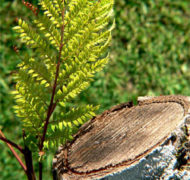A Time to Plant and a Time to Uproot
Blog / Produced by The High Calling
Editor's Note: According to Ecclesiastes 3, "There is a time for everything...." Not everything on that list, however, comes to us easily. Some items confound, others liberate, and none of them surrender to our wills entirely. The following article is part of a series that explores the complexity of these 14 poetic lines.
The bookends of life in the garden from Ecclesiastes 3 have a deep relevance to me these days. Six months ago, I planted our garden with hopeful green shoots of onions, tiny carrot seeds bursting with potential, and tomato starts that promised sweet fruit. In those heady days of spring, I walked the garden like Johnny Appleseed, full of gratitude for the sun, the rain, and another growing season.
Now that fall has arrived here in the Pacific Northwest, I feel more like the Grim Reaper as I walk the limp remains, plucking up whole pepper plants with California Wonders still attached and putting bug-riddled cabbages out of their misery with a turn of the shovel.
The garden has become a graveyard.
Regardless of how much I want to keep the season going, there is no way around this ending. If I don’t do the plucking myself, nature will do it for me with powdery mildew or freezing temperatures. It’s an exercise in giving up, and giving up is hard.
I recently asked one of the wise old farmers from our local market about life on the farm now that the harvest is over. He mentioned that he needs to clear out his greenhouses for winter crops, but his wife is still holding onto her plants from the summer. They’ve stopped growing and producing, but she can’t bring herself to pluck them up. He said, with a tone of knowing compassion, “It’s hard, after all that work nurturing a plant, to tear it out.”
As difficult as it is to accept the end of the growing season, the author of Ecclesiastes invites us to embrace this experience as an important part of the journey. God has made everything beautiful in its time, and we are challenged to consider the strange beauty of death in the garden.
In a never-give-up culture that celebrates taking initiative and working without boundaries, this seasonal limit brings an important, grounded lesson that echoes far beyond the confines of the garden. There is a time to plan and cultivate with energy and passion, but there is also a time to acknowledge that our efforts have run their course, and we have reached limits beyond our control. There is a time for the sweet satisfaction of harvest, but there is also a time for scarcity...when we are forced to trust that there will be enough to get us through to the next growing season. There is a time to start, and there is a time to uproot what was started.
As much as I resist these lessons, I always come around to appreciating them. I’m glad to have a rest from weeding and worrying about the weather. I’m glad for a pause in the action to reflect and plan for the next growing season. Most of all, I’m grateful for the reminder that even when my efforts to create come to an unceremonious end, I am sustained by a Creator God who provides for me in every season.
That seems to be the lesson that reverberates throughout the stops and starts of Ecclesiastes 3. At some point, we all must face the reality of giving up our self-sufficiencies and the illusion of independence. Life is best lived with these vanities laid bare, and in this giving up, we find the seeds of faith and life in the God who loves and sustains us.
* * * * *
The "Season for Everything" Collection
- A Time to Be Born and a Time to Die
- A Time to Plant and a Time to Uproot
- A Time to Kill and a Time to Heal
- A Time to Tear Down and a Time to Build
- A Time to Weep and a Time to Laugh





